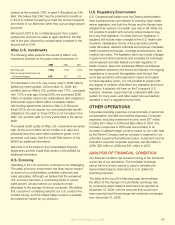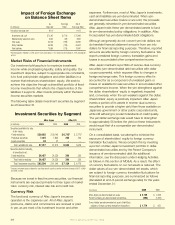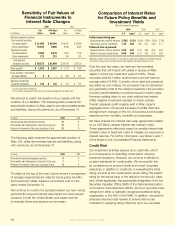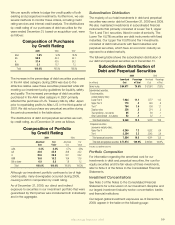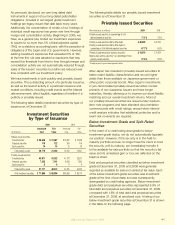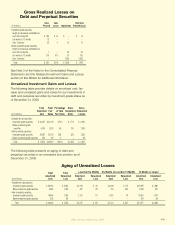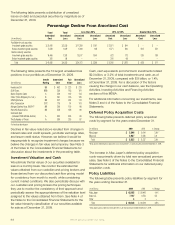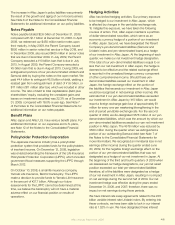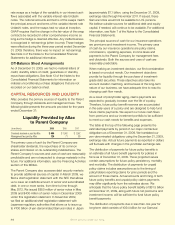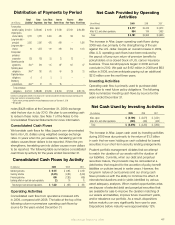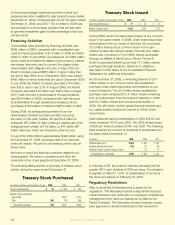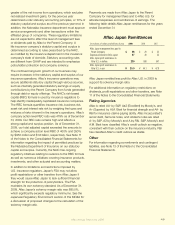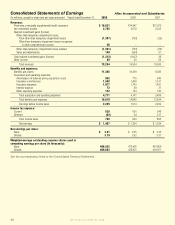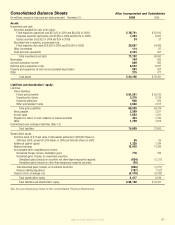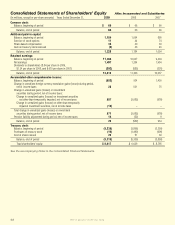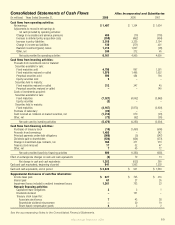Aflac 2009 Annual Report Download - page 49
Download and view the complete annual report
Please find page 49 of the 2009 Aflac annual report below. You can navigate through the pages in the report by either clicking on the pages listed below, or by using the keyword search tool below to find specific information within the annual report.
The increase in Aac Japan’s policy liabilities was primarily
the result of the growth and aging of our in-force business.
See Note 6 of the Notes to the Consolidated Financial
Statements for additional information on our policy liabilities.
Notes Payable
Notes payable totaled $2.6 billion at December 31, 2009,
compared with $1.7 billion at December 31, 2008. In April
2009, we redeemed our $450 million senior notes upon
their maturity. In May 2009, the Parent Company issued
$850 million in senior notes that are due in May 2019, and
in December 2009, also issued $400 million in senior notes
that are due in December 2039. In July 2009, the Parent
Company executed a ¥10 billion loan that is due in July
2015. In August 2009, the Parent Company executed a
¥5 billion loan that is due in August 2015. During 2009, we
extinguished portions of our yen-denominated Uridashi and
Samurai debt by buying the notes on the open market. We
paid ¥4.4 billion to extinguish ¥6.0 billion of debt, yielding a
realized gain from extinguishment of debt of ¥1.6 billion, or
$17 million ($11 million after-tax), which we included in other
income. The ratio of debt to total capitalization (debt plus
shareholders’ equity, excluding the unrealized gains and
losses on investment securities) was 22.3% as of December
31, 2009, compared with 18.0% a year ago. See Note 7
of the Notes to the Consolidated Financial Statements for
additional information on our notes payable.
Benefit Plans
Aac Japan and Aac U.S. have various benet plans. For
additional information on our Japanese and U.S. plans,
see Note 12 of the Notes to the Consolidated Financial
Statements.
Policyholder Protection Corporation
The Japanese insurance industry has a policyholder
protection system that provides funds for the policyholders
of insolvent insurers. On December 12, 2008, legislation
was enacted extending the framework of the Life Insurance
Policyholder Protection Corporation (LIPPC), which included
government scal measures supporting the LIPPC through
March 2012.
On October 10, 2008, a small life insurance company,
Yamato Life Insurance, led for bankruptcy. The LIPPC
made a decision to provide funds to Yamato Life Insurance
in the amount of ¥27.7 billion. Although our future
assessments for the LIPPC cannot be determined at this
time, we believe the bankruptcy will not have a material
adverse effect on our nancial position or results of
operations.
Hedging Activities
Aac has limited hedging activities. Our primary exposure
to be hedged is our investment in Aac Japan, which
is affected by changes in the yen/dollar exchange rate.
To mitigate this exposure, we have taken the following
courses of action. First, Aac Japan maintains a portfolio
of dollar-denominated securities, which serve as an
economic currency hedge of a portion of our investment
in Aac Japan. Second, we have designated the Parent
Company’s yen-denominated liabilities (Samurai and
Uridashi notes and yen-denominated loans) as a hedge
of our investment in Aac Japan. At the beginning of each
quarter, we make our net investment hedge designation.
If the total of our yen-denominated liabilities is equal to or
less than our net investment in Aac Japan, the hedge is
deemed to be effective and the related exchange effect
is reported in the unrealized foreign currency component
of other comprehensive income. Should these yen-
denominated liabilities exceed our investment in Aac
Japan, the foreign exchange effect on the portion of
the liabilities that exceeds our investment in Aac Japan
would be recognized in net earnings (other income). We
estimate that if our yen-denominated liabilities exceeded
our investment in Aac Japan by ¥10 billion, we would
report a foreign exchange gain/loss of approximately $1
million for every one yen weakening/strengthening in the
end-of-period yen/dollar exchange rate. For the second
quarter of 2009, we de-designated ¥678 million of our yen-
denominated liabilities, which was the amount by which our
yen-denominated liabilities exceeded our yen net investment
position in Aac Japan. The ¥678 million was reduced by
¥600 million during the quarter when we extinguished a
portion of our outstanding Samurai debt (see Note 7 of
the Notes to the Consolidated Financial Statements for
more information). We recognized an immaterial loss in net
earnings (other income) during the quarter ended June
30, 2009, for the negative foreign exchange effect on the
portion of our yen-denominated liabilities that was not
designated as a hedge of our net investment in Japan. At
the beginning of the third and fourth quarters of 2009 when
we reassessed our hedge designations, our yen net asset
position exceeded our total yen-denominated liabilities;
therefore, all of the liabilities were designated as a hedge
of our net investment in Aac Japan, resulting in no impact
on net earnings during the second half of 2009. Our net
investment hedge was effective during the years ended
December 31, 2008, and 2007; therefore, there was no
impact on net earnings during those periods.
We have interest rate swap agreements related to the ¥20
billion variable interest rate Uridashi notes. By entering into
these contracts, we have been able to lock in our interest
rate at 1.52% in yen. We have designated these interest
Aflac Annual Report for 2009 45


